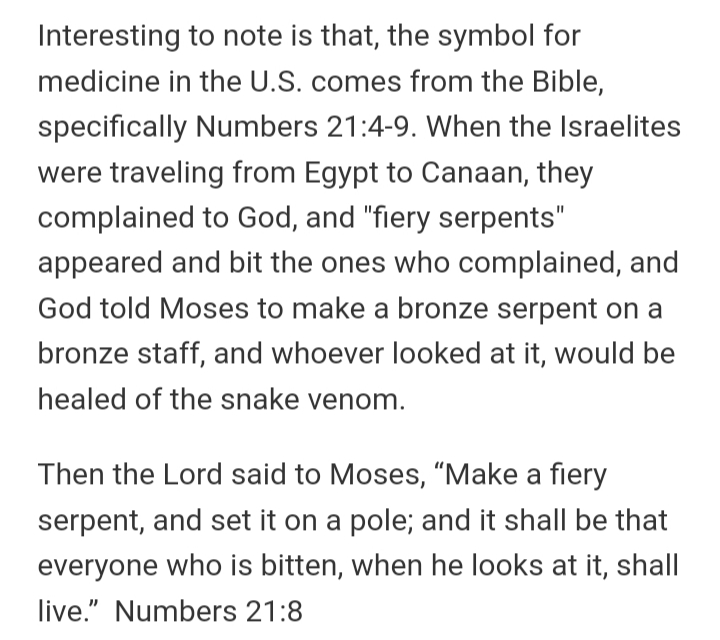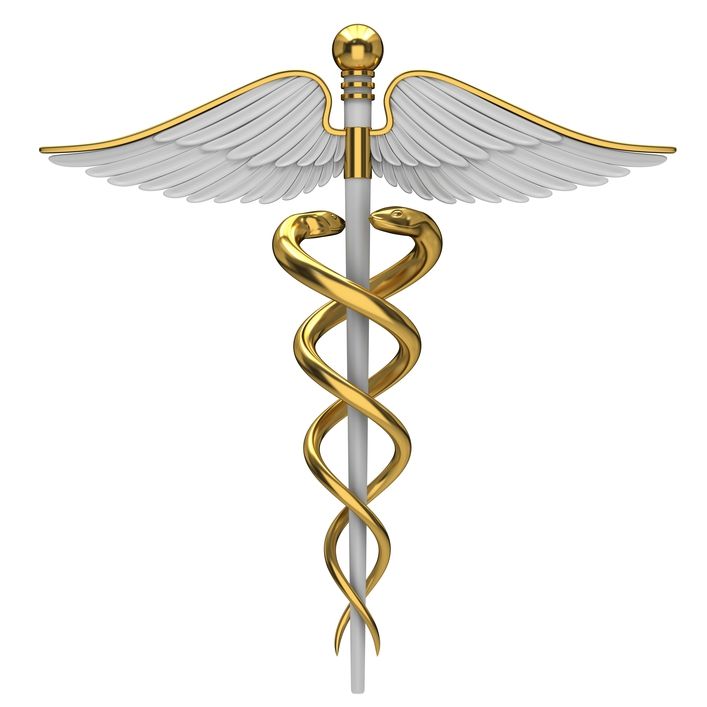The difference between the Rod of Asclepius and the Caduceus.
The Rod of Asclepius is an ancient Greek symbol associated with medicine, consisting of a serpent coiled around a rod.
In ancient Greek religion and mythology, Asclepius was the god of medicine and healing.
His daughters are Hygieia (goddess of cleanliness), Iaso (goddess of recuperation from illness), Aceso (goddess of the healing process), Aglea (the goddess of splendor and adornment), and Panacea (goddess of universal remedy).
The myth of Asclepius
Asclepius is the god of Healing. He is the son of Apollo (god of healing, truth, and prophecy) and the nymph Coronis.
While pregnant with Asclepius, Coronis secretly took a second, mortal lover. When Apollo found out, he sent Artemis to kill her. While Coronis burned on the funeral pyre, Apollo felt pity and rescued the unborn child from the corpse. Asclepius was taught about medicine and healing by the wise centaur Cheiron and became so skilled in it that he succeeded in bringing one of his patients back from the dead. Zeus, king of the gods, felt that the immortality of the Gods was threatened and struck down the healer with a thunderbolt. At Apollo’s request, Asclepius was placed among the stars as Ophiuchus, the serpent-bearer.
In the Iliad, Homer mentions Asceplius only as a skillful physician and the father of two Greek doctors at Troy, Machaon, and Podalirius; in later times, however, he was honoured as a hero and eventually worshiped as a god. The cult began in Thessaly but spread to many parts of Greece. Because it was supposed that Asclepius effected cures of the sick in dreams, the practice of sleeping in his temples in Epidaurus in South Greece became common. In 293 B.C. his cult spread to Rome.
Asclepius was frequently represented standing and dressed in a long cloak with bare breast; his usual attribute was a staff with a serpent coiled around it. This staff is the only true symbol of medicine.

The Roman world
In the Roman adaptation of the Greek pantheon, Asclepius was identified with the god Vediovis.
He was portrayed as a young man holding a bunch of arrows, pilum, (or lightning bolts) in his hand and accompanied by a goat. Romans believed that Vediovis was one of the first gods to be born. He was a god of healing and became associated with the Greek Asclepius.
The probable medical origin of the single serpent around a rod
There are two hypotheses as to where the Rod of Asclepius came from and how it became associated with medicine. One is the ‘worm theory’, which dates to the Ebers papyrus (~1500 BC), one of the first ancient Egyptian medical documents. The Ebers papyrus describes a treatment for worms.
Parasitic worms, such as the Guinea Worm, were common in ancient times: they crawled around the victim’s body, just under the skin. Physicians treated this infection by cutting a slit in the patient’s skin, just in front of the worm’s path. As the worm crawled out the cut, the physician carefully wound the pest around a stick until the entire animal had been removed.
Ancient physicians probably advertised this common service by putting a sign showing a worm on a stick in front of their house.
The other hypothesis dates to the Bible. In Biblical Lore, Moses carried a bronze staff, around which a bronze serpent was wound. Anyone bit by a serpent needed only look at the staff to be healed of the snake’s venom.

This particular medical technique, I’m fairly certain, is not practiced today.
The Rod of Asclepius is the logo of the World Health Organization and the symbol of the American Medical Association.
The Caduceus
The Rod of Asclepius symbol is often confused with the Caduceus, symbol of commerce associated with the Greek god Hermes.
The Rod of Asclepius combines the snake with a rod, a simple tool. The serpent with its change of skin symbolizes rebirth and fertility.
On the other hand, the Caduceus symbol consisted of a rod with two snakes coiled around it. The English word comes from the Latin caduceus, which echoes the ancient Greek kèrix, translated as herald.
The word was mainly used to indicate the rod assigned to the Greek god Hermes as herald (messenger) of the gods and patron of commerce.
This rod was represented with two wings on the top and two snakes to symbolize diligence and prudence, two characteristics very necessary in trading activities.
In Greek religion and mythology, Hermes was a god of transitions and boundaries. He was protector and patron of travelers, herdsmen, invention, and trade.
In the Roman adaptation of the Greek pantheon, Hermes was identified with the Roman god Mercury, who developed many similar characteristics, such as being the patron of commerce.
The Caduceus symbol alluded directly to the myth of Hermes, who saw two snakes fighting and touched them with his rod so that the two animals would stop fighting. Of course, peace is necessary for trade to flourish.
Originally, the Caduceus was a rod or olive branch ending in two shoots and decorated with garlands or ribbons. Later the garlands were interpreted as two snakes entwined in opposite directions with their heads facing each other. A pair of wings, in token of Hermes’ speed, was attached to the staff above the snakes.
As mentioned above, the Caduceus is often mistakenly used as a symbol of medicine because it is similar to the Rod of Asclepius.
Summarizing, the Caduceus has two snakes on the staff and wings at the top. The Rod of Asclepius has a single snake and no wings.
In Dan Brown’s Inferno, Dr. Elizabeth Sinskey uses a lapis lazuli Rod of Asclepius as an amulet.

Confusion of the Rod of Asclepius with the Caduceus
From the early 16th century onwards, the Rod of Asclepius and the Caduceus of Hermes were widely used as printers’ marks in general publishing, especially as frontispieces to pharmacopoeias in the 17th and 18th centuries. Over time the Rod of Asclepian emerged as an independent symbol of medicine.
Despite the unequivocal claim of the Rod of Asclepius representing medicine (and healing), the Caduceus appears to be the more popular symbol of medicine in the United States, probably due to simple confusion between two symbols. The practice was widely adopted by medical publishers in the United States. The Caduceus was thus inadvertently connected in the minds of some physicians with medicine.
The dual snake symbol is the current emblem of many prominent U.S. medical organizations, and according to a survey conducted in 1993 of 242 medical logos, over 38% of American medical associations and over 63% of American hospitals use the Caduceus as their symbol.
This seems especially strange in light of the fact that many organizations use both the Caduceus and the Rod of Asclepius.
For instance, within the army, the Caduceus is the sign of the U.S. Army Medical Corps, but the U.S. Army Medical Department uses the Rod of Asclepius.
Many military organizations throughout the world have included the Rod of Asclepius in the symbol to represent their medical corps. The English Army (1889), French Army (1798), German Army (1868), and even the US Air Force use this symbol.
Many medical organizations have also incorporated the Rod of Asclepius into their symbol: The American Medical Association, the New England Journal of Medicine, the American College of Physicians, and the World Health Organization, to name a few.
A review of 12 medical dictionaries from England, France, and the U.S. prior to 1903, plus two dictionaries dealing with the French language from the 9th through the 16th centuries, showed no medical connection with the word Caduceus.

